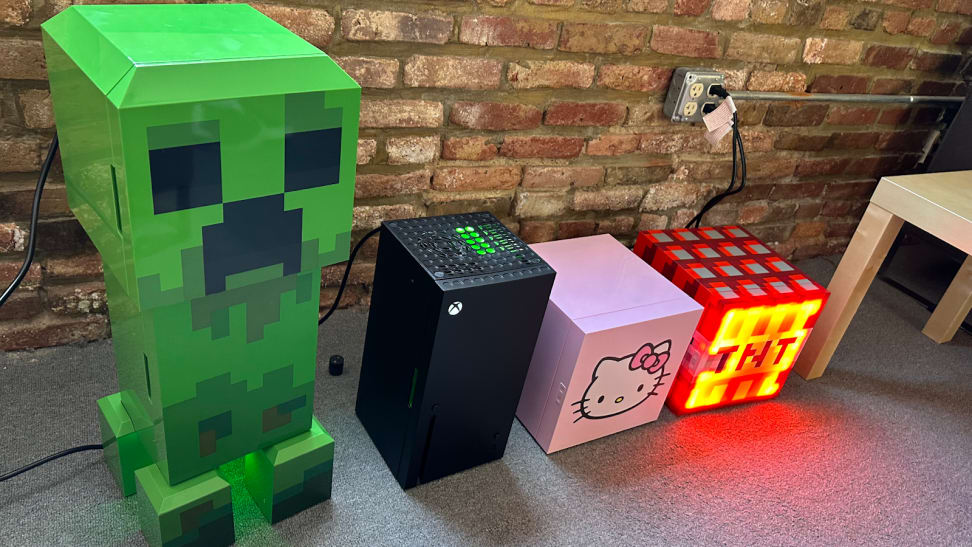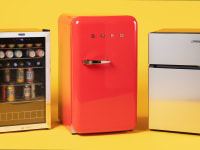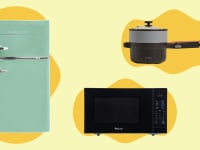Mini-fridge or thermoelectric cooler? You likely want the former
You may be chilling your Coke a lot less effectively
 Credit:
Reviewed / Mark Brezinski
Credit:
Reviewed / Mark Brezinski
Products are chosen independently by our editors. Purchases made through our links may earn us a commission.
The new school year is approaching and everyone is busy outfitting dorm rooms, study nooks, or gaming setups with every amenity necessary to get their work (or gaming) done in style. And a mini-fridge is often part of the ideal setup.
If you've been shopping for a new mini-fridge recently, you may have noticed some of the more popular options don’t look like your average mini-fridge.
Many feature some novelty to their design, whether they're in the shape of an Xbox, or look like a Minecraft block, or picture Hello Kitty's face on the front. They're petite, perfect for small spaces, and they keep just enough drinks chilled. It's easy to see why such fun designs are so popular.
However, dig into the user reviews and you'll find something else they have in common beyond their small size and fun design: a suspicious number of negative reviews all saying the fridge conked out after only a few months. What gives?

There's an important difference between novelty thermoelectric coolers and true min-fridges.
Well, all these novelty “mini-fridges” have one last thing in common: They're actually thermoelectric coolers.
We wouldn't blame you if you didn't notice that detail, because all the models we checked are repeatedly labeled as mini-fridges in their marketing copy. They are only sometimes referred to as thermoelectric coolers, and the term isn't often explained.
So let's do some explaining.
Before you buy that new novelty "mini fridge," let's quickly go over how traditional mini-fridges work, where thermoelectric coolers differ, and how knowing those differences can prevent you from wasting your money.
The cooling technology of traditional mini-fridges

Mini-fridges use the same technology as a full-sized fridge, just scaled down.
It makes sense to call most traditional mini-fridges "mini-fridges" because they use the same cooling technology as a full-size fridge: a compressor and refrigerants.
Refrigerants can switch between a gas and a liquid at relatively low temperatures. In liquid form, they're able to absorb heat from the interior of a fridge, then cycle to the coils on the back of the fridge to disperse that stored heat in its gaseous state. The compressor then does as its name implies and applies pressure to compress the gas and change it back into a liquid so the cycle can repeat itself.
How does a thermoelectric cooler work, and how are they different from compressor coolers?

True mini-fridges have a compressor protected by a fully vented back panel, while thermoelectric coolers use a small heat sink to absorb excess heat.
Thermoelectric coolers use a completely different cooling technology than a traditional compressor and refrigerant system.
The way they work is actually relatively complicated—read up on the Peltier effect if you really want to get into it—but essentially they use electricity and two different types of conductors that operate to create a heat differential between them. This generates a hot side and a cold side.
In a thermoelectric cooler, the cold side is the interior of the cooler while the hot side is typically located on the back of the cooler, attached to a heat sink, which absorbs the excess heat.
Thermoelectric cooling is useful because it lacks the moving parts or circulating liquid of the traditional compressor-refrigerant system. It's also much easier to scale down to smaller sizes or awkward shapes.
How thermoelectric coolers can be problematic
Their cooling power depends on the ambient temperature of the room

Fridges need to maintain temperatures between 32°F and 40°F to ensure everything is properly refrigerated. Some thermoelectric coolers we tested were unable to get below 50°F.
While thermoelectric coolers have their uses, their different technology creates some limitations you may not be expecting if you're used to a traditional compressor-refrigerant fridge—some of which are important to know about before purchasing one.
To start, all of the thermoelectric coolers we tested, such as the Xbox Replica X and the Minecraft Green Creeper were unable to guarantee that they'd reach or maintain a safe refrigerator temperature.
This is because thermoelectric cooling is entirely dependent on ambient conditions. The "hot side" is typically room temperature, while the "cool side" is only capable of going so low relative to its hot side. If the ambient temperature rises, the "cool side" won't be able to keep as cool. This is just a limitation of the cooling technology.
Proper refrigeration requires temperatures to be kept under 40°F to keep bacteria growth at bay. While this is relatively easy for a traditional fridge, it isn't guaranteed for a thermoelectric cooler depending on the ambient temperature of the room it's in.
Out of all the thermoelectric coolers we tested, none could keep their temperatures consistently under 40°F. Most had temperatures that wandered all over the 50s and several showcased temperature swings of up to 10°F as the ambient temperature rose and fell between day and night.
Of course, if you're only trying to keep drinks and nonperishable items cool, this isn't a huge problem. Your drinks may be slightly more tepid, but that's it. The issue is if you try to keep perishable items in these devices thinking it will have the same temperature performance as an actual refrigerator.
Again, this is an easy mistake to make because the word "fridge" appears repeatedly on both the packaging and marketing materials. While there is a warning label on the device itself (we'll get to that next), you won't see that label until after you've purchased the product.
Keep in mind that we tested these coolers in our office, which has relatively stable temperatures due to a centralized heating and cooling system. If you're using this cooler in a room with less steady temperatures you'll see even more exaggerated results.
Thermoelectric coolers can't run indefinitely

We scoured the instructions and this one label was the only indication that this device operates differently than a mini-fridge.
That's right: You also can't keep a thermoelectric cooler running like you would a fridge.
This is where all those one-star reviews come in. All of the thermoelectric coolers we tested have multiple reports from users who were unaware that continuous operation would break their cooler. Several of these reviews mention seeing some warning label or information card alluding to a risk, but didn't understand because they are used to normal fridges.
Honestly, we don't blame them. On the thermoelectric coolers we tested, the warning labels outlining the problem are vague at best, saying "This cooler is not intended for continuous use—we recommend you turn the cooler off intermittently."
This is a terrible warning label. It in no way indicates what will happen if you do choose to use the cooler continuously. How strong of a "recommendation" is this warning? And don't get us started on how unhelpful "intermittently" is as guidance for when to power the machine down.
We're currently stress-testing a few thermoelectric coolers to figure out exactly how long they can run before they overheat and break—we'll update this article with a link to our results.
Make sure you know what you're buying—and buy what you actually need
Thermoelectric coolers can be useful devices. Many are extremely portable and can keep sandwiches cold on a trip to the beach or a picnic. They can be more environmentally friendly due to their lack of refrigerant, and their lack of moving parts means they may have a lower chance of breaking down—if you use them correctly.
That being said, calling thermoelectric coolers "mini-fridges" seems outright misleading. They aren't capable of maintaining safe temperatures like most traditional mini-fridges. They can't be left on indefinitely or they'll overheat and break, and the instructions provided to avoid this outcome can only be described as "vibes-based."
If you just need to keep drinks chilled and will remember to power it down every so often, a thermoelectric cooler will suffice.
If you want to make sure your perishables will be kept safely refrigerated, you need a good mini-fridge— not a thermoelectric cooler.


